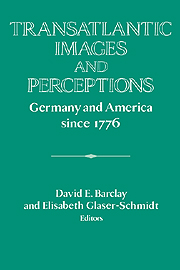Book contents
- Frontmatter
- Introduction
- 1 “Through a Glass, Darkly”: Changing German Ideas of American Freedom, 1776-1806
- 2 “Germans Make Cows and Women Work”: American Perceptions of Germans as Reported in American Travel Books, 1800-1840
- 3 Weary of Germany - Weary of America: Perceptions of the United States in Nineteenth-Century Germany
- 4 “Auch unser Deutschland muss einmal frei werden”: The Immigrant Civil War Experience as a Mirror on Political Conditions in Germany
- 5 Different, But Not Out of This World: German Images of the United States Between Two Wars, 1871-1914
- 6 From Cultureto Kultur : Changing American Perceptions of Imperial Germany, 1870-1914
- 7 The Reciprocal Vision of German and American Intellectuals: Beneath the Shifting Perceptions
- 8 Germany and the United States, 1914-1933: The Mutual Perception of Their Political Systems
- 9 Between Hope and Skepticism: American Views of Germany, 1918-1933
- 10 “Without Concessions to Marxist or Communist Thought”: Fordism in Germany, 1923-1939
- 11 The Continuity of Ambivalence: German Views of America, 1933-1945
- 12 Cultural Migration: Artists and Visual Representation Between Americans and Germans During the 1930s and 1940s
- 13 Representations of Germans and What Germans Represent: American Film Images and Public Perceptions in the Postwar Era
- 14 Chancellor of the Allies? The Significance of the United States in Adenauer's Foreign Policy
- 15 American Policy Toward German Unification: Images and Interests
- 16 Unification Policies and the German Image: Comments on the American Reaction
- Index
15 - American Policy Toward German Unification: Images and Interests
Published online by Cambridge University Press: 05 January 2013
- Frontmatter
- Introduction
- 1 “Through a Glass, Darkly”: Changing German Ideas of American Freedom, 1776-1806
- 2 “Germans Make Cows and Women Work”: American Perceptions of Germans as Reported in American Travel Books, 1800-1840
- 3 Weary of Germany - Weary of America: Perceptions of the United States in Nineteenth-Century Germany
- 4 “Auch unser Deutschland muss einmal frei werden”: The Immigrant Civil War Experience as a Mirror on Political Conditions in Germany
- 5 Different, But Not Out of This World: German Images of the United States Between Two Wars, 1871-1914
- 6 From Cultureto Kultur : Changing American Perceptions of Imperial Germany, 1870-1914
- 7 The Reciprocal Vision of German and American Intellectuals: Beneath the Shifting Perceptions
- 8 Germany and the United States, 1914-1933: The Mutual Perception of Their Political Systems
- 9 Between Hope and Skepticism: American Views of Germany, 1918-1933
- 10 “Without Concessions to Marxist or Communist Thought”: Fordism in Germany, 1923-1939
- 11 The Continuity of Ambivalence: German Views of America, 1933-1945
- 12 Cultural Migration: Artists and Visual Representation Between Americans and Germans During the 1930s and 1940s
- 13 Representations of Germans and What Germans Represent: American Film Images and Public Perceptions in the Postwar Era
- 14 Chancellor of the Allies? The Significance of the United States in Adenauer's Foreign Policy
- 15 American Policy Toward German Unification: Images and Interests
- 16 Unification Policies and the German Image: Comments on the American Reaction
- Index
Summary
The peaceful revolutions of 1989-90 toppled regimes and transformed international relations. After four decades in which time itself seemed to have become frozen, events rushed forward at a dizzying pace. In a nutshell, the collapse of Communism in Central and Eastern Europe overthrew the Soviet empire, destroyed the Warsaw Pact, and dissolved the Council for Mutual Economic Assistance (COMECON). The unexpected rising of suppressed peoples shattered the relative stability of the Cold War and ushered in a period of rapid and unpredictable change. By ending the East-West confrontation, this rupture opened up undreamt-of vistas of action which also tested the established relationship between the United States and the Federal Republic of Germany. It was in effect a redefining movement in transatlantic relations that was fraught with exciting possibilities for crises and new beginnings.
Not surprisingly, American opinion responded to the new situation much like an individual reacts to an unforeseen event, namely, in terms of its prior experiences with the Germans. The Central and East European rising stirred up layers of public images in the United States that had accumulated through personal contact and media projection over two centuries. In the case of Germany negative stereotypes, created by the enmity of the world wars and the shock of the Holocaust, predictably raised old fears of aggression and domination. But earlier historical memories of immigration as well as education, and recent impressions based on private contacts and the stability of the Federal Republic, also engendered more positive views that spurred new hopes. These mixed feelings sparked a lively debate in the American press and academic community which, although ostensibly about the future, was largely couched in terms of the past.
- Type
- Chapter
- Information
- Transatlantic Images and PerceptionsGermany and America since 1776, pp. 333 - 352Publisher: Cambridge University PressPrint publication year: 1997



